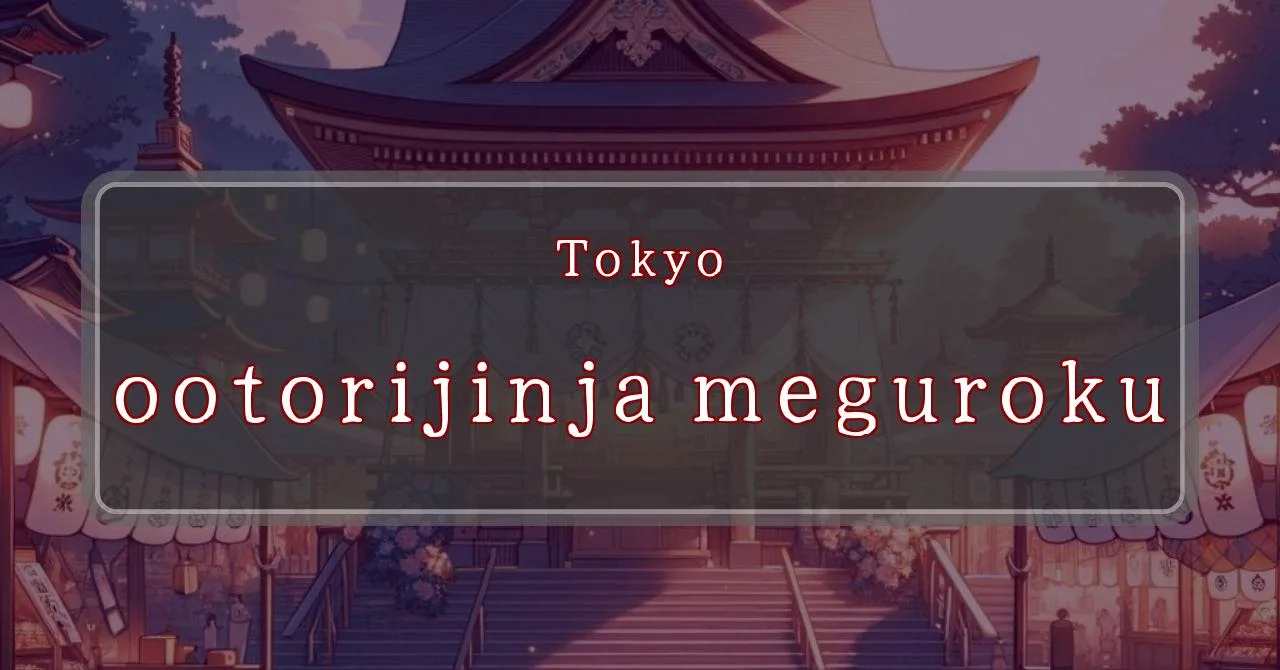Enchanting shrine festival in Tokyo, a fusion of tradition and vibrancy
Basic Information
Ootori Shrine is a Shinto shrine located in the Meguro district of Tokyo, Japan. It is dedicated to the god Japan武尊 (Yamatotakeru-no-Mikoto), who is said to have visited the area in the 3rd century AD.
- Address: 3-1-2 Shimo-Meguro, Meguro-ku, Tokyo 153-0064
- Phone Number: 03-3494-0543
- Access: 7-minute walk from JR Yamanote Line, Tokyu Meguro Line, Tokyo Metro Namboku Line, and Toei Mita Line “Meguro Station” (West Exit)
- Festival Days: September 9th (Sunday closest to September 9th), 2024
Main Events and Attractions of the Festival
The Ootori Shrine Festival is a vibrant and lively event that attracts many visitors each year. Here are some of the main events and attractions of the festival:
Mikoshi Procession
One of the highlights of the festival is the mikoshi procession. A mikoshi is a portable shrine that is carried through the streets by a team of people. The mikoshi of Ootori Shrine is particularly large and impressive, and it is carried by a team of over 100 people. The procession is a lively and colorful event, and it is a great opportunity to see the local community come together to celebrate.
Kagura Performance
Kagura is a traditional Japanese performing art that is often performed at Shinto shrines. During the Ootori Shrine Festival, kagura is performed by a group of trained dancers and musicians. The performance tells the story of the god Japan武尊 (Yamatotakeru-no-Mikoto), and it is a beautiful and moving experience.
Yatai (Food Stalls)
No Japanese festival is complete without yatai, or food stalls. At the Ootori Shrine Festival, there are many yatai selling a variety of delicious food and drinks. From classic festival fare like takoyaki and yakisoba to more unique offerings like deep-fried butter and chocolate-covered bananas, there is something for everyone to enjoy.
Tori-no-Ichi Market
The Tori-no-Ichi Market is a special market that is held at Ootori Shrine on the酉の日 (Day of the Rooster) of the Japanese calendar. The market is said to have originated in the Edo period, and it is a popular place to buy good luck charms and other items. The market is also a great place to experience the lively atmosphere of the festival.
Blessings and Deities
Ootori Shrine is dedicated to the god Japan武尊 (Yamatotakeru-no-Mikoto), who is said to have visited the area in the 3rd century AD. Japan武尊 is a legendary hero who is known for his bravery and military prowess. He is also said to be the ancestor of the Japanese imperial family.
Ootori Shrine is also home to a number of other deities, including:
- Kunitokotachi-no-Mikoto: The god of the land and the underworld.
- Ototachibana-hime-no-Mikoto: The wife of Japan武尊 and the goddess of safe childbirth.
- Susanoo-no-Mikoto: The god of storms and the sea.
- Inari-no-Kami: The god of rice and prosperity.
Visitors to Ootori Shrine can pray to these deities for blessings in a variety of areas, including health, wealth, and good luck.
Origin and History
The origins of Ootori Shrine are unclear, but it is believed to have been founded in the Heian period (794-1185). The shrine was originally located in a different part of Meguro, but it was moved to its current location in 1651.
Ootori Shrine has a long and rich history. It has been visited by many famous people over the years, including the shogun Tokugawa Ieyasu and the emperor Meiji.
Tips and Notes for Visitors
Here are some tips and notes for visitors to Ootori Shrine:
- The shrine is open every day from 9:00 AM to 5:00 PM.
- Admission is free.
- There is a large parking lot available for visitors.
- The shrine is a popular destination for weddings and other ceremonies.
- There are a number of restaurants and shops located near the shrine.
Parking Information
There is a large parking lot available for visitors to Ootori Shrine. The parking lot is located next to the shrine, and it can accommodate over 100 cars.
The parking fee is 500 yen per day.
Popular Stalls and Food Carts in Recent Years
| Type of Stall | Description |
|---|---|
| Takoyaki | A staple at Japanese festivals. Characterized by a crispy outside and a creamy inside. |
| Jaga Butter | A simple yet popular snack of hot potatoes lavishly topped with melted butter. |
| Baby Castella | Small castella cakes, sweet and fluffy treats enjoyed by children and adults alike. |
| Grilled Ayu with Salt | Fresh ayu fish grilled whole with salt, a savory taste of Japanese summer. |
| Shaapin | A unique gourmet item influenced by foreign cuisine, with a chewy skin wrapping the filling. |
| Okonomiyaki | A Japanese grilled dish where you often choose your own ingredients for a personalized flavor. |
| Cotton Candy | A fluffy, sweet snack that’s extremely popular with children. |
| Chocolate Banana | A banana coated in chocolate, a fun and visually appealing dessert. |
| Kushiyaki | Various types of ingredients skewered and grilled, an easy-to-enjoy snack. |
| Yakisoba | Fried noodles mixed with a special sauce, a fast food favorite in Japan. |



